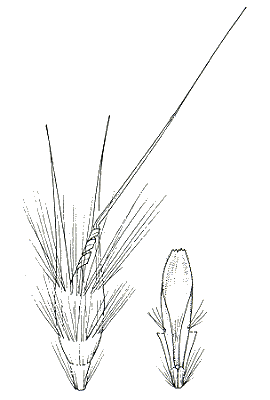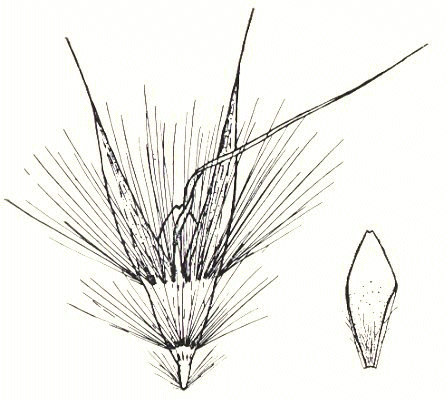Rytidosperma tenuius (Steud.) Erikson,
Hansen & Sunding. Fl. Macaronesia ed.2, 1:93 [Jan.] (1979).
Classification. (GPWG 2001) : Subfamily Danthonioideae. Tribe
Danthonieae.
Basionym and/or
Replacement Name: Plinthanthesis
tenuior Steud., Syn. Pl. Glumac. 1: 14 (1855 [1853]).
Type of Basionym or
Protologue Information: HT: D'Urville s.n., Australia: New South
Wales: Port Jackson (P).
Recent synonyms:
Notodanthonia tenuior (Steud.) S.T.Blake, Danthonia tenuior
(Steud.) Conert, Austrodanthonia tenuior (Steud.) H.P. Linder.
Key references
(books and floras): [2002] D.Sharp & B.K.Simon, AusGrass, Grasses of
Australia, [2006] J.Jessop, G.R.M.Dashorst, F.M.James, Grasses of South
Australia (297), [2008] S.W.L.Jacobs, R.D.B.Walley & D.J.B.Wheeler, Grasses
of New South Wales (147).
Illustrations:
[2005] K.Mallet (ed.), Flora of Australia 44B: Poaceae 3 (Fig.
10, I-J), [2006] J.Jessop, G.R.M.Dashorst, F.M.James, Grasses of South
Australia (297, Fig. 234), [2008]
S.W.L.Jacobs, R.D.B.Whalley & D.J.B.Wheeler, Grasses of New South Wales,
4th edn (147).
Derivation: L.
more slender. More delicate than related species.
Habit.
Perennial. Culms erect, 23–90 cm tall, 3–4 -noded. Mid-culm nodes glabrous.
Leaf-sheaths glabrous on surface or hairy. Ligule a fringe of hairs.
Leaf-blades flat or involute, 10–20 cm long, 1–3 mm wide. Leaf-blade surface
glabrous or indumented.
Inflorescence.
Inflorescence solid, a panicle. Panicle linear or lanceolate or ovate, 5–20 cm
long.
Spikelets.
Spikelets pedicelled. Fertile spikelets many flowered, with at least 2 fertile
florets (3–6), comprising 3–6 fertile floret(s), with diminished florets at the
apex, cuneate, laterally compressed, 9–17 mm long.
Glumes. Glumes
similar, thinner than fertile lemma. Lower glume elliptic, membranous, without
keels, 5 -nerved. Upper glume elliptic, 10–17 mm long, membranous, without
keels, 3–5 -nerved. Upper glume surface asperulous.
Florets.
Fertile lemma 2–3.8 mm long, without keel, 9 -nerved. Lemma apex lobed, awned,
3 -awned. Median (principal) awn from a sinus, 9–12 mm long overall, with a
twisted column. Lateral lemma awns present. Lodicules present. Anthers 3. Grain
1.8–2.4 mm long.
Continental
Distribution: Australasia.
Australian
Distribution: South Australia, Queensland, New South Wales, Victoria,
Tasmania.
South Australia:
Flinders Ranges, Eastern, Northern Lofty, Southern Lofty, South-eastern. Queensland:
Port Curtis, Burnett, Darling Downs, Moreton, Maranoa. New South Wales:
North Coast, Central Coast, South Coast, Northern Tablelands, Central
Tablelands, Southern Tablelands, North-Western Slopes, Central-Western Slopes,
South-Western Slopes. Victoria: East Gippsland, Eastern Highlands,
Gippsland Plain, Grampians, Midlands, Otway Plain, Wilsons Promontory,
Riverina, Snowfields, Volcanic Plain. Tasmania: North East, Midlands,
East Coast.
Notes. R.
tenuius intergrades with several species. It is close to R. fulvum,
and differs from it by the glabrous to sparsely villous lemma back between the
indumentum rows, and by the shorter paleas. However, in many specimens of R.
tenuius there are scattered hairs between the rows, thus approaching the condition
found in R. fulvum, and collections from Tasmania have longer paleas. It
also approaches R. erianthum via a high-altitude form, which
superficially looks like R. tenuius, but which has the glabrous
palea-back of R. erianthum. R. tenuius may often be separated by
the rather slender inflorescence.
Widespread
from southern Queensland to Adelaide and Tasmania, altitude 5–750 m, on
Tablelands usually in somewhat damp habitats, rarely dominant; along the
coastal shelf a very common constituent of disturbed road verges. Flowers Nov.
to Dec.





